Every family historian wants to know the ship their ancestor came over on and the date that it arrived.
Along with Thanksgiving, tomorrow we’ll be celebrating the arrival of the Mayflower in 1620.
That trip took 66 days. Remarkably, when my ancestor William Kemp came to America 233 years later that trip still took a long time: 56 days.
Genealogists often can find the date and the name of the ship their ancestor came over on—but is there more to the story?
Is there a way to find out more details about our ancestors?
Yes—we can find the rest of the story and, importantly, pass it down in the family. We can find it in GenealogyBank’s 3 centuries of newspaper archives.
Stories from the Mayflower Voyage
In the case of the Pilgrims coming to America, the old newspapers fill in the story, reporting that the Mayflower voyage was very difficult. The Boston Herald tells us that “halfway across the ocean, the point of no return, the Mayflower ran into the first of ‘many fierce storms.’”

One violent storm at sea cracked and buckled the main beam. The news article reports that the Pilgrims aboard the Mayflower were terrified. Luckily they had brought along nails, screws and other items for building homes in the New World, and were able to use a “great iron scrue” to “force the beam back into place.”
What about My Ancestor’s Story?
I have always wanted to know exactly when my ancestor William Kemp came to America, and I finally found that date and the name of the ship on the free Internet site CastleGarden.org.
William arrived in America on 21 October 1853, a passenger on the ship Benjamin Adams.
There it is in the ship passenger list: the name of the ship and the date of his arrival!
Done.
With this information, I did a search on FamilySearch and found confirmation.

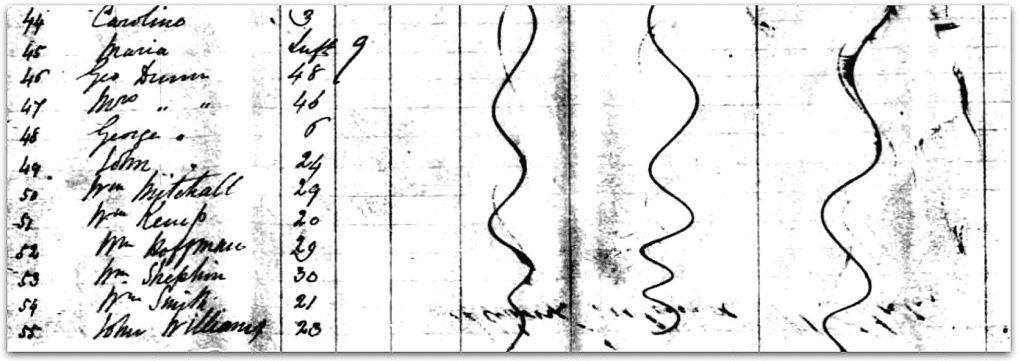
But, Was There More to William’s Story?
The name of the ship and the arrival date are good to know, but I wanted to find out more about William’s story—and old newspapers, such as GenealogyBank’s Historical Newspaper Archives, are a good resource for finding our ancestors’ stories.
Searching GenealogyBank by the name of the ship—not the name of my ancestor—I found this article in the American and Commercial Daily Advertiser reporting that the Benjamin Adams left Friday 26 March 1852 on its maiden voyage from Bath, Maine, to Baltimore, Maryland.
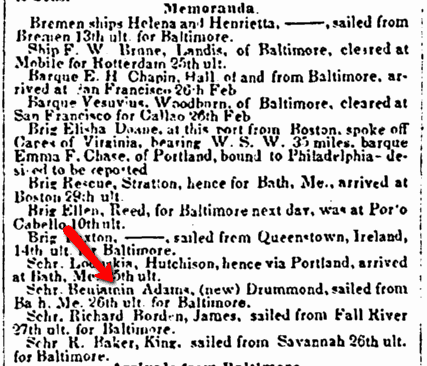
Advertisements for “the splendid ship Benjamin Adams” highlighted its comfortable accommodations of 6 to 8 cabins above deck and another 75 to 80 accommodations in steerage below deck.
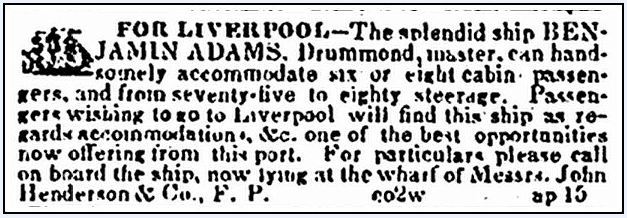
Once William Kemp made his decision to emigrate he would have taken a steamship from Ireland to Liverpool, England, arriving at Clarence Dock along the Mersey River in Liverpool.
Liverpool has a series of docks along the banks of the Mersey River. It was one of the major hubs of immigration to America.
According to Liverpool and Emigration in the 19th and 20th Centuries, Information Sheet number 64:
By 1851 it had become the leading emigration port in Europe with 159,840 passengers sailing to North America, as opposed to the second port, Le Havre, [France] with 31,859.
This would have been the scene in mid-19th century Liverpool when William arrived to wait for his ship to America.
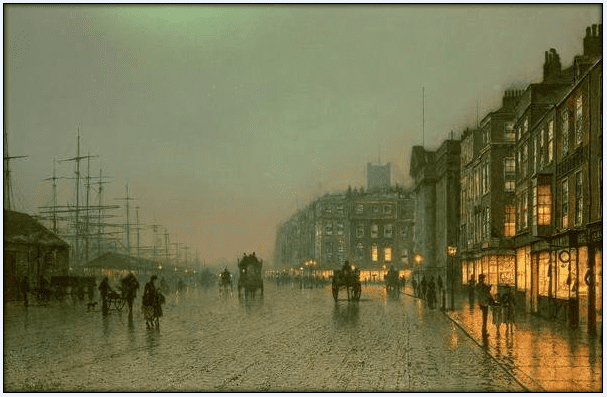
The Preparation and Movement of Ships
Here is a newspaper article reporting that the ship Benjamin Adams had moved from the dock and into the Mersey River ready to head outbound—waiting to move up the river with the aid of a tugboat that will direct it safely to the open ocean.

The big day arrived: the Benjamin Adams set sail on 24 August 1853 bound for New York City.
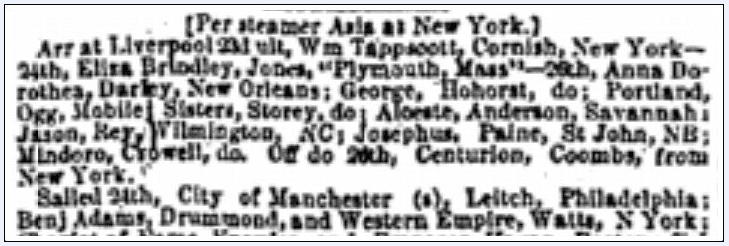
Ship Arrival Times
It was announced in the Weekly Herald newspaper that the Benjamin Adams arrived in New York City on 21 October 1853.
They made it.
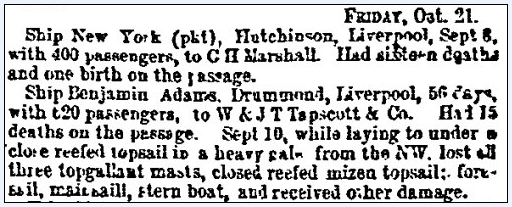
News Stories of Trouble at Sea
Newspapers can tell us just how difficult the cross-Atlantic trip was for our ancestors. That Weekly Herald article gave more details on the trip. The voyage took 56 days with 620 passengers on board. The ship was hit by a storm, suffering major damage:
Sept. 10, while laying to under a close reefed topsail in a heavy gale from the NW, lost all three topgallant masts, closed reefed mizzen topsail, foresail, mainsail, stern boat, and received other damage.
The old news article also reported: “Had 15 deaths on the passage.”
A week later the Weekly Herald told us why so many had died.

Cholera was killing passengers on ship after ship:
…it is pretty certain that the disease which carried them off was cholera, that fatal malady which is making such havoc among the shipping in Europe…The sickness on the Benjamin Adams was decidedly cholera.
Cholera was a major problem in England and Europe in the mid-1800s. In 1853-1854 it killed more than 31,000 people in London alone. It would be another year before the pioneering work of John Snow, M.D. (1813-1858) discovered the cause and cure for the repeated cholera epidemics.
The Albany Evening Journal had this report about the arrival of the Benjamin Adams.
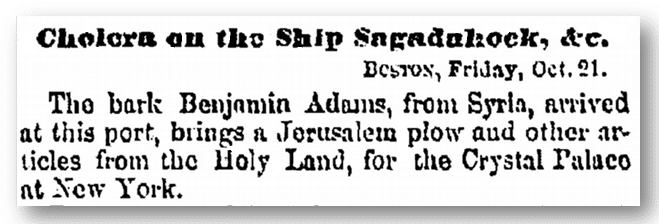
Passenger Ship Routes
Wait—the Benjamin Adams arrived “from Syria” bringing “a Jerusalem plow and other articles from the Holy Land, for the Crystal Palace at New York”? Notice that it stopped in Boston, Massachusetts, before continuing on to New York City.
When was the ship in Syria?
Digging deeper into GenealogyBank’s old newspapers—there it is.
The ship was in Beirut on July 25th before going to Liverpool to pick up William Kemp and the other 619 passengers.
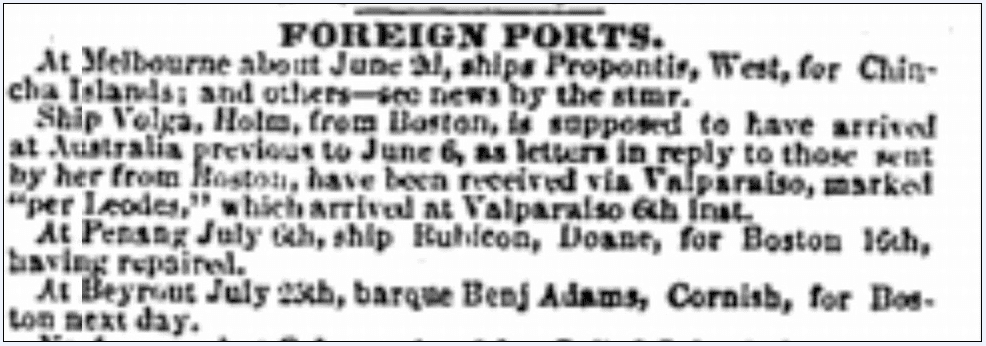
The Springfield Republican gave more details.
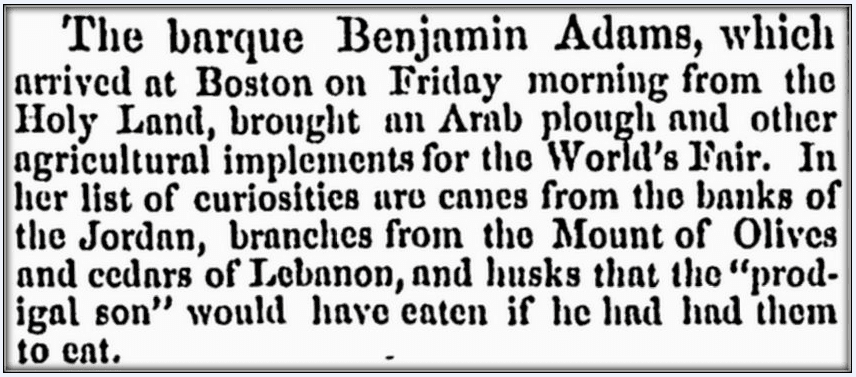
In addition to the “Arab plough,” the Benjamin Adams brought:
…canes from the banks of the Jordan, branches from the Mount of Olives and cedars of Lebanon, and husks that the “prodigal son” would have eaten if he had had them to eat.
Conclusion
When I began searching for the name of the ship and the date that William Kemp arrived in America, I only knew that William was born in Corradownan, County Cavan, Ireland. I did not know any additional details about William’s cross-Atlantic trip.
Thanks to CastleGarden.org and FamilySearch.org, I learned that he came over on the ship Benjamin Adams and that he arrived in New York City on 21 October 1853.
Those were the basic facts, but it took the old newspapers in GenealogyBank’s deep newspaper archives to fill in the rest of the story. These newspapers gave me the details of how dangerous the trip was, reported that it took an incredible 56 days, provided a description of the ship’s accommodations, and listed the interesting ancient relics it was bringing from Syria to the Exhibition of the Industry of All Nations—the World’s Fair—held in 1853 in New York City.
Old documents give us the names, dates and places, but newspapers have the stories that give life to our ancestors and make their experiences memorable and unforgettable.
